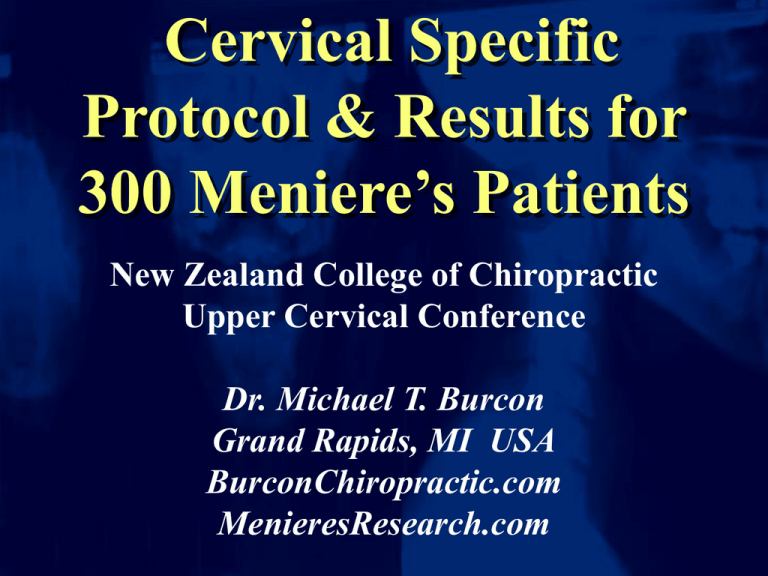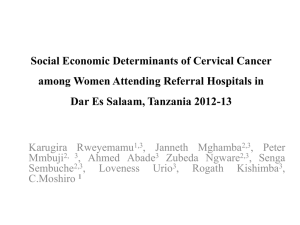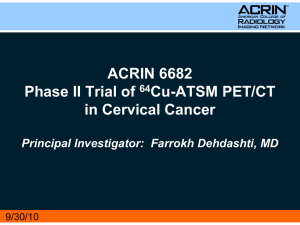Meniere`s Disease Research
advertisement

Cervical Specific Protocol & Results for 300 Meniere’s Patients New Zealand College of Chiropractic Upper Cervical Conference Dr. Michael T. Burcon Grand Rapids, MI USA BurconChiropractic.com MenieresResearch.com Prosper Meniere, MD Director of the Paris Institute for Deaf Mutes First to describe condition in 1861 that was later named after him. Upon autopsy, it was later discovered that his first MD patient did not have Meniere’s disease! Medical Dx of Meniere’s Subjective diagnosis by exclusion: Blood tests to rule out chronic inner ear infections Brain MRI to rule out tumors or MS Audiogram to test for low frequency hearing loss Electronystagraphy measures Cochlear branch of CN VIII with alternating hot and cold water and air Electrocochleography creates a graph from a needle that pierces the ear drum to access the inner ear VEMP Test (Vestibular Evoked Myogenic Potential) Meniere’s Disease Dx 1. At least two spontaneous episodes of vertigo lasting at least 20 minutes. 2. Sensorineural low frequency hearing loss confirmed by audiometry. 3. Tinnitus and/or perception of aural fullness. Medical Treatment Avoid salt, caffeine, nicotine, alcohol and stress Antivert, diuretics, anticholinergics, antihistamines, barbiturates, antidepressants and/or sleeping pills Steroids (Oral or injected into ear) Inner ear hair cell destruction with Gentamicin Endolymphatic shunt to drain endolymph Labyrinthectomy (Inner ear destruction) Vestibular neurectomy (Brain surgery to sever nerve) Injections Endolymphatic Sac Surgery Success rate after 2 years Vertigo eliminated: 38% Placebo effect: 35% Vestibular Dissection Inner Ear Destruction September 18, 1895 Harvey Lillard Black male janitor presented with almost total deafness Case history: He was working in a stooped, cramped position when he felt something pop and heard a crack in his neck, immediately losing his hearing. D.D. Palmer, D.C., Magnetic Healer Discovered a bump on the back of Mr. Lillard’s neck at the level of C2 (Axis) Performed the first chiropractic adjustment, restoring Harvey’s hearing. BJ Palmer, DC Son of DD Palmer Took over Palmer Chiropractic College from his father Started researching upper cervical specific chiropractic in 1931 ”Chiropractic is specific, or it is nothing.” Endolymphatic Hydrops “The accumulation of the fluid of the membranous labyrinth of the ear, thought to be caused by the over production or under absorption of that fluid,” Merck Manual. Question: What is the Cause of the problem? Meniere’s is not an inner ear disease. It is a middle ear syndrome highlighted by Eustachian tube dysfunction, caused by an upper cervical subluxation complex. Ménière's disease not only includes the symptom complex consisting of attacks of vertigo, low-frequency hearing loss, and tinnitus but comprises symptoms related to the Eustachian tube, the upper cervical spine, the temporomandibular joints, and the autonomic nervous system. “Insertion of a middle-ear ventilation tube can temporarily alleviate Ménière's symptoms, suggesting Eustachian tube dysfunction (ETD) is a contributing feature. Clinical practice also shows that treating disorders of the upper and lower cervical spine and temporomandibular joints can lessen Ménière's disease symptoms. Similarly, stellate ganglion blocks can be beneficial in controlling Ménière's disease symptoms, highlighting the influence of the autonomic nervous system. In this hypothetical reflex pathway, irritation of facet joints can first lead to an activated anterior cervical sympathetic system in the mediolateral cell column; simultaneously leading to an axon reflex involving nociceptive neurons, resulting in neurogenic inflammation and the prospect of ETD. This reflex pathway is supported by recent animal experiments.” Based upon 470 consecutive cases diagnosed by ENT's, presenting to my practice for care of vertigo. Meniere’s Disease is a Syndrome caused by Whiplash It takes an average of 15 years from the time of the trauma before the onset of symptoms. WHIPLASH: Cervical subluxation complex comprised of vertebral facet fixation with the skull positioned anteriorly and tilted or translated laterally, creating neurogenic inflammation resulting in peripheral autonomic nervous system sympathetic irritation, reduced vertebral artery blood and CSF flow, increased mandibular branch CN V motor activity affecting the tensor veli palatini, causing Eustachian tube and TMJ dysfunction and irritation to the nucleus of CNVIII. All of the following conditions exhibit hyperactivation of the Trigeminal ganglion when symptomatic on PET scan: Meniere’s disease Migraine headache Trigeminal neuralgia Bell’s palsy Additionally, patients with one of these conditions are twice as likely to experience another one of these conditions in their lifetime. More than 9 out of 10 benefit from cervical specific chiropractic care. Where would this 29 year old female patient be referred? Neurologist or ENT? Left sided face pain, sore throat, left ear pain, pain radiating down left arm, balance problem, trouble swallowing, low back pain, hip pain, cervicalgia, hearing problem, insomnia and sensitive lips. It is called an upper cervical subluxation complex, because it is complex! There is no one chiropractic technique that works best… for every patient, every time. Anterior Occiput Normal Posterior Atlas Rear ended auto accident Posterior C5 Subluxation Right Head Translation “T-Bone” Vehicular Accident Chiropractic Treatment Detailed case history including letter from ENT and copies of tests used to DX MD Titronics TyTron C-3000 cervical thermographs Modified, modified Prill leg check analysis Modified Blair Cervical X-rays Adjustments as determined by pattern work 15 minute rest after adjustment with re-check Thermography Pre and Post Adjustment Graphs of Patient with Right Unilateral Meniere’s C5 Adjusted PIL with Pierce technique Atlas adjusted PIL with Blair technique Followed by 15 minute rest before re-scan William G Blair, DC Started researching the atlanto-occipital joints in 1951 The Blair technique is the only non-orthogonal upper cervical specific technique Clarence E. Prill, D.C. 1925 - 2005 The Prill Chiropractic Spinal Analysis Technique did not utilize x-rays Blair modified Prill checks from arms to legs “Modified” Modified Prill Leg Check Protocol Interactive presentation at 11th Annual Vertebral Subluxation Research Conference Intraexaminer repeatability tested very good Interexaminer repeatability tested excellent Cervical Syndromes “Most significant indication of upper cervical subluxation,” Dr Burcon. Derifield/Thompson Cervical Syndrome Test- Hold patient’s shoes with thumbs under the heel, while applying very mild cephalic pressure. Lift the legs one inch off from the table, keeping the shoes one inch apart. Compare the welts to estimate the leg length differential. Notate differential of short leg to closest 1/8 inch. Instruct patient to slowly turn their head to the right, then to the left. If the legs change length only while turning to the right, notate the amount of change as a right cervical syndrome (RCS). If the legs change length only while turning to the left, notate the amount of change as a left cervical syndrome (LCS). If the leg length changes while turning the head in both directions, notate the total amount of change as a bilateral cervical syndrome (BLCS). If there is no change in leg length when the head is turned, there is no cervical syndrome. Perform following tests to determine which upper cervical vertebrae is subluxated. First Published by Ruth Jackson, MD in 1956 Modified Blair X-Rays All 300 consecutive Meniere’s patients tested positive for upper cervical subluxations. 3 Cervical X-rays taken and analyzed: Lateral, A-P Open Mouth & Nasium. All 300 film studies showed evidence of upper cervical subluxation and whiplash, although cervical trauma was denied by over 50% of these patients. 4 Blair Atlas Subluxation Listings Anterior and Superior on the Right (ASR) Anterior and Superior on the Left (ASL) Posterior and Inferior on the Right (PIR) Posterior and Inferior on the Left (PIL) Atlas listings for 300 Patients 0- Anterior and Superior on opposite side of involved ear 18- Anterior and Superior on the side of the involved ear 12- Posterior and Inferior on the side of the involved ear 270- Posterior and Inferior on the opposite side of the involved ear Levels of Cervical Involvement Upper Cervicals When atlas is the major subluxation, vertigo with vomiting are the major symptoms. When axis is the major subluxation, hearing loss, ear fullness and tinnitus are the major symptoms. Pairs of Subluxations Atlas and C5 most common Axis and C6 next most common Both pairs are the next most common: these patients typically can not drive or work. They rarely leave their homes. Side Posture with Drop Upper Cervical Adjustment BJ Palmer, DC Lesion Pre-Adjustment (C1 PIL) Patient with Right Unilateral Meniere’s 6 Weeks Post (Juxta) Patient is off Medication and Symptom Free Upper Cervical Protocol for Ten Meniere’s Patients Same paper published in Upper Cervical Subluxation Complex, A Review of the Chiropractic and Medical Literature, by Kirk Ericksen. Lippincott, Williams & Wilkens, 2004 VERTIGO 10 8 Frequency 6 and Intensity 4 2 0 Series1 1 2 3 4 Time Span 1. Pre-adjustment 2. 6 Weeks Post-adjustment 3. 1 Year Post 4. 2 Years Post 5. 3 Years Post 6. 4 Years Post 5 6 Are you comfortable with patients traveling thousands of miles… Expecting a miracle?








